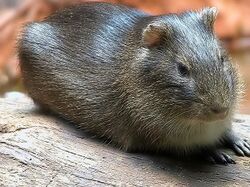Biology:Cavia
| Cavia Temporal range: Pliocene – Holocene
| |
|---|---|

| |
| Cavia aperea, or Brazilian guinea pig | |
| Scientific classification | |
| Domain: | Eukaryota |
| Kingdom: | Animalia |
| Phylum: | Chordata |
| Class: | Mammalia |
| Order: | Rodentia |
| Family: | Caviidae |
| Subfamily: | Caviinae |
| Genus: | Cavia Pallas, 1766 |
| Type species | |
| Cavia cobaya | |
| Species | |
| |
Cavia is a genus in the subfamily Caviinae that contains the rodents commonly known as guinea pigs or cavies.[1] The best-known species in this genus is the domestic guinea pig, Cavia porcellus, a meat animal in South America and a common household pet outside of that continent.
Former taxonomic controversy
Cavia is classified in order Rodentia, although there was once a minority belief in the scientific community that evidence from mitochondrial DNA and proteins suggested the Hystricognathi might belong to a different evolutionary offshoot, and therefore a different order.[2] If this had been so, it would have been an example of convergent evolution. However, this uncertainty is largely of historical interest, as abundant molecular genetic evidence now conclusively supports classification of Cavia as rodents.[3][4] This evidence includes draft genome sequences of Cavia porcellus and several other rodents.[5]
Species
Historically, there has been little consensus in regard to the number of Cavia forms and their taxonomic affiliations. Morphological characters differentiating between Cavia species are limited and levels of inter- and intraspecific morphologic variation have not been well documented, thus, interpretations have varied and resulted in very different taxonomic conclusions. Three scientists disagreed on the number of species, Tate (1935) recognized 11 species, while Cabrera (1961) recognized 7, and Huckinghaus (1961) recognized only 3. Recent scientific compilations have generally followed either Cabrera or Huckinghaus.[6]
At least five wild species of guinea pig are recognised, in addition to the domestic form:
- Cavia aperea – Brazilian guinea pig, widespread east of the Andes
- Cavia fulgida – shiny guinea pig, eastern Brazil
- Cavia intermedia – intermediate guinea pig, Moleques do Sul islands, Santa Catarina, Brazil, first described in 1999
- Cavia magna – greater guinea pig, Uruguay, southeast Brazil
- Cavia porcellus – domestic guinea pig, wild ancestor is likely:
- Cavia tschudii – montane guinea pig, Peru south to northern Chile and northwest Argentina
Some authors also recognise the following additional species:
- Cavia anolaimae (often considered a synonym of C. porcellus or a subspecies of C. aperea) – Colombia
- Cavia guianae (often considered a synonym of C. porcellus or a subspecies of C. aperea) – Venezuela, Guyana, Brazil
- Cavia patzelti [7] (often considered a synonym of C. aparea) - Ecuador
In addition, four fossil species have been identified:[8]
- †Cavia cabrerai - early Pliocene Argentina
- †Cavia galileoi - late Pliocene Argentina
- †Cavia lamingae - late Pleistocene Brazil
- †Cavia vates - late Pleistocene Brazil
References
- ↑ Woods, C.A.; Kilpatrick, C.W. (2005). "Infraorder Hystricognathi". in Wilson, D.E.; Reeder, D.M. Mammal Species of the World: A Taxonomic and Geographic Reference (3rd ed.). Johns Hopkins University Press. pp. 1552–1553. ISBN 978-0-8018-8221-0. OCLC 62265494. http://www.departments.bucknell.edu/biology/resources/msw3/browse.asp?id=13400170.
- ↑ Stiefel, Chana Freeiman (1996). "Family feud – genetic evidence seems to show that guinea pigs are not rodents". Science World. http://www.thefreelibrary.com/Family+feud.-a018773108.
- ↑ "Archived copy". http://www.timetree.org/pdf/Honeycutt2009Chap76.pdf. (and references therein)
- ↑ ""Molecular Biology and Evolution," Vol 11, 593–604". http://mbe.oupjournals.org/cgi/content/abstract/11/4/593.
- ↑ "UCSC Genome Browser Gateway". http://genome.ucsc.edu/cgi-bin/hgGateway?hgsid=271122373&clade=mammal&org=Guinea%20pig&db=0.
- ↑ Dunnum, Jonathan L, Salazar-Bravo, Jorge (21 January 2010), "Molecular systematics, taxonomy, and biogeography of the genus Cavia (Rodentia:Caviidae) Page 1
- ↑ Donnum, J.L.; Salazar-Bravo, J. (November 2010). "Molecular systematics, taxonomy and biogeography of the genus Cavia (Rodentia: Caviidae)". Journal of Zoological Systematics and Evolutionary Research 48 (4): 376–388. doi:10.1111/j.1439-0469.2009.00561.x.
- ↑ Candela, A.M.; Bonini, R.A. (July 2017). "A new guinea pig (Rodentia, Caviomorpha) from northwestern Argentina: implications for the origin of the genus Cavia". Journal of Vertebrate Paleontology 37 (4): e1352591. doi:10.1080/02724634.2017.1352591. Bibcode: 2017JVPal..37E2591C. http://sedici.unlp.edu.ar/handle/10915/107574.
External links
| Wikisource has the text of the 1911 Encyclopædia Britannica article Cavy. |
Wikidata ☰ Q286088 entry
 |


